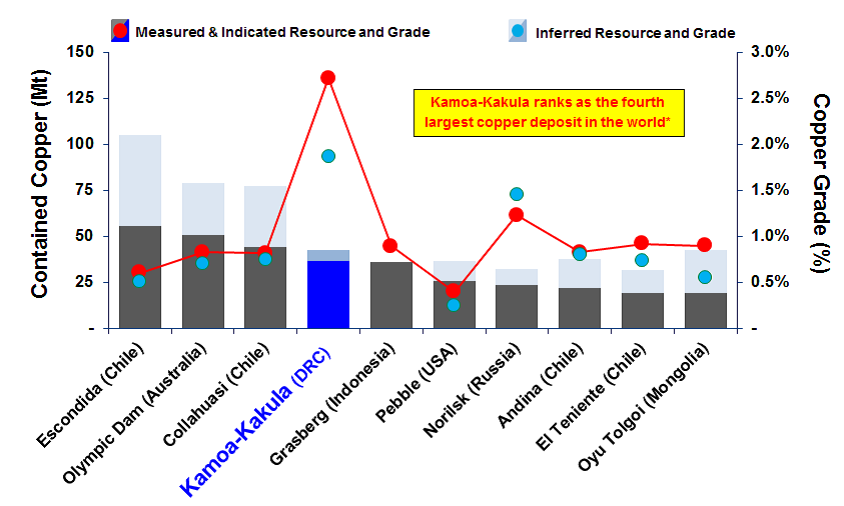Exploration drilling at the Kamoa North prospect area, on the 397-km2 Kamoa-Kakula mining licence, approximately 25 km west of the mining centre of Kolwezi in the Democratic Republic of Congo (DRC), has successfully delineated two new, continuous corridors of shallow copper mineralization containing zones of thick, high-grade copper.
The newly delineated copper corridors occur on the western flank of the un-mineralized Kamoa Dome at Kamoa North. The most significant corridor trends north and south for more than nine kilometres before swinging to the northwest and is projected to continue onto the adjacent Western Foreland exploration licences that are 100%-owned by Ivanhoe Mines. The second corridor trends west-southwest, away from the Kamoa Dome and toward the West Scarp Fault, over a distance of 3 to 4 km.
“Our latest exploration success, at Kamoa North, provides additional options for mine planning and sequencing at Kamoa-Kakula,” said Robert Friedland. “The unparalleled strength and continuity of the high-grade mineralized trends on the Kamoa-Kakula Project also bode well for the potential for further success right next door, on Ivanhoe’s 700-km2 Western Foreland exploration licences, north and west of Kamoa-Kakula.”
The tier-one Kamoa-Kakula project is a joint venture between Ivanhoe Mines, Zijin Mining and the DRC government.
An independent Mineral Resource estimate published last February established Kamoa-Kakula as the world’s fourth-largest copper discovery. Kamoa-Kakula’s copper grades are the highest, by a wide margin, of the world’s top 10 copper deposits, as the picture shows.
The Kamoa North exploration area is some 12 km north of Kamoa’s Kansoko mine development and approximately 20 km north of the Kamoa-Kakula project’s planned initial mine at the Kakula deposit. The discovery area already is accessible by an all-season road that connects with the provincial road to Kolwezi and is close to the newly installed electricity line running from Kamoa North to the planned Kansoko and Kakula mines.
Ivanhoe and Zijin are continuing with exploration and step-out drilling around the presently defined Mineral Resource boundaries at the Kamoa and Kakula discoveries. Eight drills are operating at Kamoa-Kakula. One rig is drilling resource-extension holes at Kakula Main; two rigs are drilling infill holes at Kakula West; three rigs are drilling step-out holes at Kakula West; and two rigs are drilling exploration/step-out holes at Kamoa North. Approximately 74,000 m of a planned 81,000-m, 2018 drilling program have been completed to date this year.
The PFS for the planned, initial 6 Mt/y Kakula mine is expected to be completed early in 2019. This will provide more detailed information related to the project’s economic assumptions and will incorporate results from detailed engineering and optimization work.
Ivanhoe and Zijin also are exploring potential options to expand future production. The 2017 PEA noted the potential for a 12 Mt/y scenario, to be achieved through the sequential development of both the Kakula and Kansoko mines. Based on subsequent discoveries, including Kakula West, Ivanhoe and Zijin also are exploring the potential for expanding production to 18 Mt/y, and beyond.
Exploration is continuing to progress at Kamoa-Kakula and to the west, on Ivanhoe’s 100%-owned exploration licences in the adjacent Western Foreland area, where drilling recently discovered a large, high-grade zone of copper at Makoko.
Ivanhoe believes this phased approach to building what ultimately could become one of the world’s largest copper-mining complexes will provide an attractive combination of lower initial capital cost while maintaining key operating efficiencies and economies of scale.
The newly delineated, high-grade zones are near surface and flat lying. Given this depth and dip, they could be amenable to traditional, non-fill room-and-pillar-style mining that can provide high mining recovery, is highly productive and economically efficient.
Friedland said that potential construction of an additional shallow access decline in the Kamoa North area will be studied, which would expand the range of options presently being considered for the development of Kamoa-Kakula.
“We remain confident that there are more high-grade copper discoveries to be made in the area and that the ultimate scale of mining operations at Kamoa-Kakula will be much larger than currently modelled by a number of analysts and investors,” he added.
“Additional exploration successes could have a significant influence on the scale, value and timing of the overall development plan. Our Kamoa-Kakula plans will be reassessed and amended as supported by our discoveries.”











